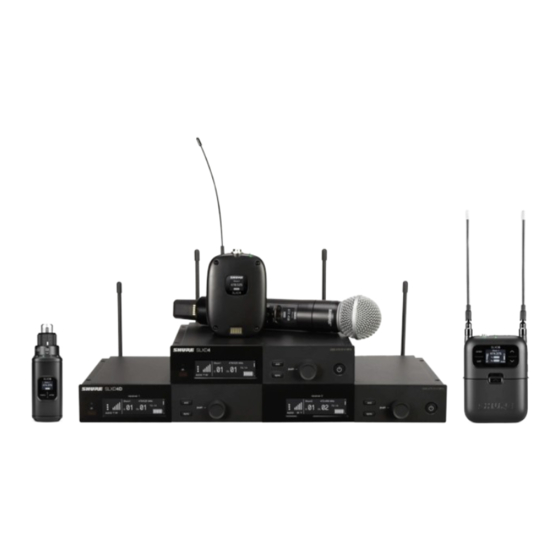Summary of Contents for Shure SLX-D
- Page 1 SLX-D Shure SLX-D Digital Wireless Shure SLX-D Digital Wireless quick start guide. Version: 5.0 (2020-G)
-
Page 2: Table Of Contents
Shure Incorporated Table of Contents Set Up the Receiver SLX-D Shure SLX-D Digital Wireless Install Transmitter Batteries IMPORTANT SAFETY INSTRUCTIONS What are Groups and Channels? Using the Guided Frequency Setup WARNING Manual Frequency Selection Important Product Information Sound Check and Gain Adjustment... -
Page 3: Slx-D Shure Slx-D Digital Wireless
Shure Incorporated SLX-D Shure SLX-D Digital Wireless IMPORTANT SAFETY INSTRUCTIONS READ these instructions. KEEP these instructions. HEED all warnings. FOLLOW all instructions. DO NOT use this apparatus near water. CLEAN ONLY with dry cloth. DO NOT block any ventilation openings. Allow sufficient distances for adequate ventilation and install in accordance with the manufacturer’s instructions. -
Page 4: Warning
Important Product Information LICENSING INFORMATION Licensing: A ministerial license to operate this equipment may be required in certain areas. Consult your national authority for possible requirements. Changes or modifications not expressly approved by Shure Incorporated could void your authority to operate the equipment. Licensing of Shure wireless microphone equipment is the user’s responsibility, and licensability de pends on the user’s classification and application, and on the selected frequency. Shure strongly urges the user to contact the ... -
Page 5: System Components
Shure Incorporated Canada Warning for Wireless This device operates on a noprotection, nointerference basis. Should the user seek to obtain protection from other radio ser vices operating in the same TV bands, a radio licence is required. For further details, consult Innovation, Science and Econom ic Development Canada’s document Client Procedures Circular CPC2128, Voluntary Licensing of LicenceExempt LowPow er Radio Apparatus in the TV Bands. Ce dispositif fonctionne selon un régime de non‑brouillage et de non‑protection. Si l’utilisateur devait chercher à obtenir une certaine protection contre d’autres services radio fonctionnant dans les mêmes bandes de télévision, une licence radio serait requise. Pour en savoir plus, veuillez consulter la Circulaire des procédures concernant les clients CPC‑2‑1‑28, Délivrance de licences sur une base volontaire pour les appareils radio de faible puissance exempts de licence et exploités dans les bandes... - Page 6 Shure Incorporated Guitar system includes: ⑥ ¼" to mini 4-pin guitar cable ⑦ SLXD1 bodypack transmitter Vocal system includes: ⑧ 6/15...
- Page 7 Shure Incorporated Microphone clip ⑨ ® ® ™ ™ SLXD2 handheld transmitter with microphone cartridge (choice of SM58 , SM86, Beta 58A , Beta 87A , Beta 87C , or KSM8/B*) *KSM8/B availability depends on region. Lavalier, Headworn, and Instrument systems include bodypack transmitter (⑦) and one of the following: ⑩...
-
Page 8: Set Up The Receiver
Shure Incorporated Combo system includes: ⑦ SLXD1 bodypack transmitter ⑨ Handheld transmitter with SM58 microphone head ⑪ WL185 lavalier microphone Set Up the Receiver Attach the included antennas to the back of the receiver. Connect the power supply to the receiver and plug the cord into an AC power source. -
Page 9: Install Transmitter Batteries
Press the power button on the receiver. Use the menu to set the system to microphone (mic) or instrument (line) level as appropriate. Install Transmitter Batteries Important: To avoid damaging transmitters, only use Shure SB903 Li-ion rechargeable batteries or 1.5V AA batteries. Bodypack: Push the tab up and open the battery door to access the battery compartment. -
Page 10: What Are Groups And Channels
Replace the battery cover. What are Groups and Channels? To minimize interference, Shure wireless systems organize RF bands into predefined groups and channels. A group is a set of compatible frequencies within a frequency band. A single frequency within a group is a channel. Tune a receiver and trans mitter to the best available channel within its group to set up your system. -
Page 11: Using The Guided Frequency Setup
Shure Incorporated All receivers in the same band should be set to the same group. You can set them manually, or use the Guided Frequency Set up to walk you through the process. Connect all the receivers in your system using Ethernet cables. For best results, use a network switch when connecting 3 or more receiver units. - Page 12 Shure Incorporated Once the sync is complete, the system is ready for use. Add a new receiver to your system: Push the control knob and select 1. Frequency Setup > 1.1 Guided Frequency Setup. 12/15...
-
Page 13: Manual Frequency Selection
Navigate to the receiver's Gain screen to test the transmitter at performance levels. Adjust the gain to keep the audio indicator within the optimal range. Reduce the gain if there is audible distortion of the audio. More Information Available Online A comprehensive online user guide is available at pubs.shure.com. Certifications Information to the user This device complies with part 15 of the FCC Rules. - Page 14 This product meets the Essential Requirements of all relevant European directives and is eligible for CE marking. Hereby, Shure Incorporated declares that the radio equipment is in compliance with Directive 2014/53/EU. The full text of the EU declaration of conformity is available at the following internet address: http://www.shure.com/europe/compliance...
- Page 15 Shure Incorporated Fax: +49-7262-92 49 11 4 Email: EMEAsupport@shure.de 15/15...















Need help?
Do you have a question about the SLX-D and is the answer not in the manual?
Questions and answers